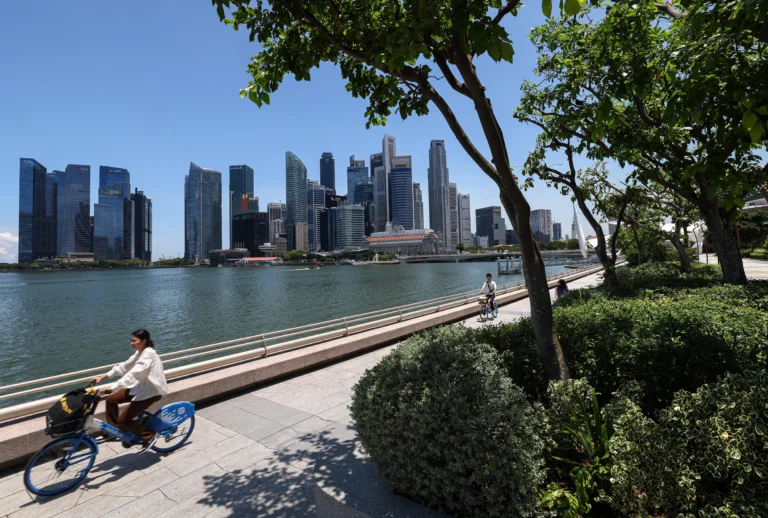[SINGAPORE] Stock market indices that include South-east Asian companies screened for their environmental, social and governance (ESG) practices tend to outperform their conventional benchmarks, said a recent report by financial services provider CGS International.
This indicates that the premium Asean companies can get from strong ESG performance – whether through higher valuations, lower costs of capital or better investor sentiment – has matured into a structural signal rather than a transient recovery, the report noted.
The report found that between May 2022 and May 2025, the ESG-aligned index FTSE4Good Asean 5 generated an annualised return of 5.1 per cent, and achieved a 3.6 per cent alpha against the FTSE Asean All-Share Index.
Similarly, the FTSE4Good Bursa Malaysia had an annualised return of 3.5 per cent over the same period, and outperformed the FTSE Bursa Malaysia EMAS index by 0.4 per cent.
“This hints that ESG momentum is no longer a lagging catch-up. It is now a repeatable source of risk-adjusted alpha, especially when integrated into capital allocation decisions,” said the report.
ESG performers and laggards
Regulatory momentum in Asean – such as the growing number of mandatory sustainability reporting requirements – as well as better transparency in ESG scoring systems, are leading investors to price ESG performers structurally, and penalise laggards as part of their Asean strategy.

Friday, 12.30 pm
ESG Insights
An exclusive weekly report on the latest environmental, social and governance issues.
Research shows that Asean stocks with low ESG risk delivered positive returns in several markets over a three-year horizon.
In Malaysia and Thailand, for example, companies with clear ESG transition pathways and consistent disclosure momentum outpaced their country indices. Institutional investors in these markets have also expressed a growing preference for sustainability-aligned portfolios for downside protection and structural exposure to regulatory and thematic tailwinds.
Similarly, poor ESG performance now carries visible commercial and financial consequences. The report noted that companies in Malaysia, Vietnam and Indonesia have faced import bans and exclusion from global supply chains due to labour or environmental violations.
Beyond reputational risks, companies with ESG controversies also face capital market penalties as they contend with higher risk premiums in bond pricing and less access to ESG-linked lending.
With local regulators such as those in Indonesia trying to mandate ESG integration into credit risk evaluation and Philippines banks having to report on ESG-linked capital allocation from this year, the financing costs for ESG laggards will inevitably go up.
“The cost of non-alignment is enforced through both market mechanisms and institutional standards. Sustainability blind spots, once overlooked, are now being priced into both trade and capital costs,” said the report.
“This shift marks a reassertion of the ESG premium through improved data quality, risk-adjusted performance and investor alignment. Where ESG was once overlooked due to insufficient signal fidelity, credible transitions and regulation-backed disclosures are now enabling that premium to be priced in,” it added.
Asean companies are also not just adopting ESG strategies to meet basic disclosure compliance, but are leveraging ESG to differentiate their business models, and deepen investor engagement.
For example, Indonesia’s Bank Central Asia aligned its credit allocation with ESG principles, excluded borrowers involved in unsustainable sectors and increased its green loan portfolio to 23 per cent of total lending in mid-2024.
“ESG is now guiding capital allocation decisions, reshaping business portfolios and offering visibility to long-term investors seeking resilience and transition alignment. This transition from reporting to repositioning strengthens the ESG alpha thesis, particularly in sectors with high regulatory exposure and stakeholder sensitivity,” said the report.
Integrating ESG into equity allocation
Besides supportive regulation, this gradual repositioning of ESG investing is a result of it being initially seen as a specialist approach into a structural allocation theme over the last three years, with institutional asset owners increasingly embedding ESG into mandates, and rebalancing equity allocation based on ESG transitions.
Malaysia’s retirement savings fund Employees Provident Fund, Singapore’s state investor Temasek, as well as Thailand’s Government Pension Fund have actively tilted their portfolios towards ESG improvers.
Allocation decisions are increasingly based on ESG trajectory signals, particularly those tied to climate reporting upgrades, governance remediation and sector-specific policy responsiveness. These trends underscore a shift in practice that ESG momentum is no longer aspirational, but already embedded in active capital allocation decisions.
“This convergence in investor behaviour and regulatory architecture ensures that ESG remains an embedded, credible theme in global capital markets. These trends create a structural tailwind for ESG-integrated portfolios, particularly in under-covered or inefficient markets where mispriced ESG momentum can generate alpha,” said the report.
Investors in Asean should therefore approach ESG integration as a structured signal used to enhance selectivity and allocate into companies exhibiting both transition visibility and valuation headroom.
Despite the growing ESG momentum in South-east Asia, the report also highlighted several risks to watch out for.
These are inconsistent disclosures and regulatory divergence across the region; superficial compliance; execution gaps when implementing ESG strategies; as well as ESG scoring instability due to changes in methodologies.


